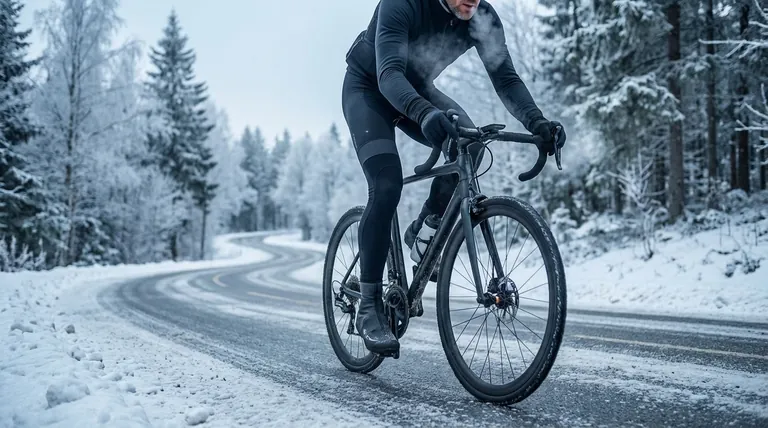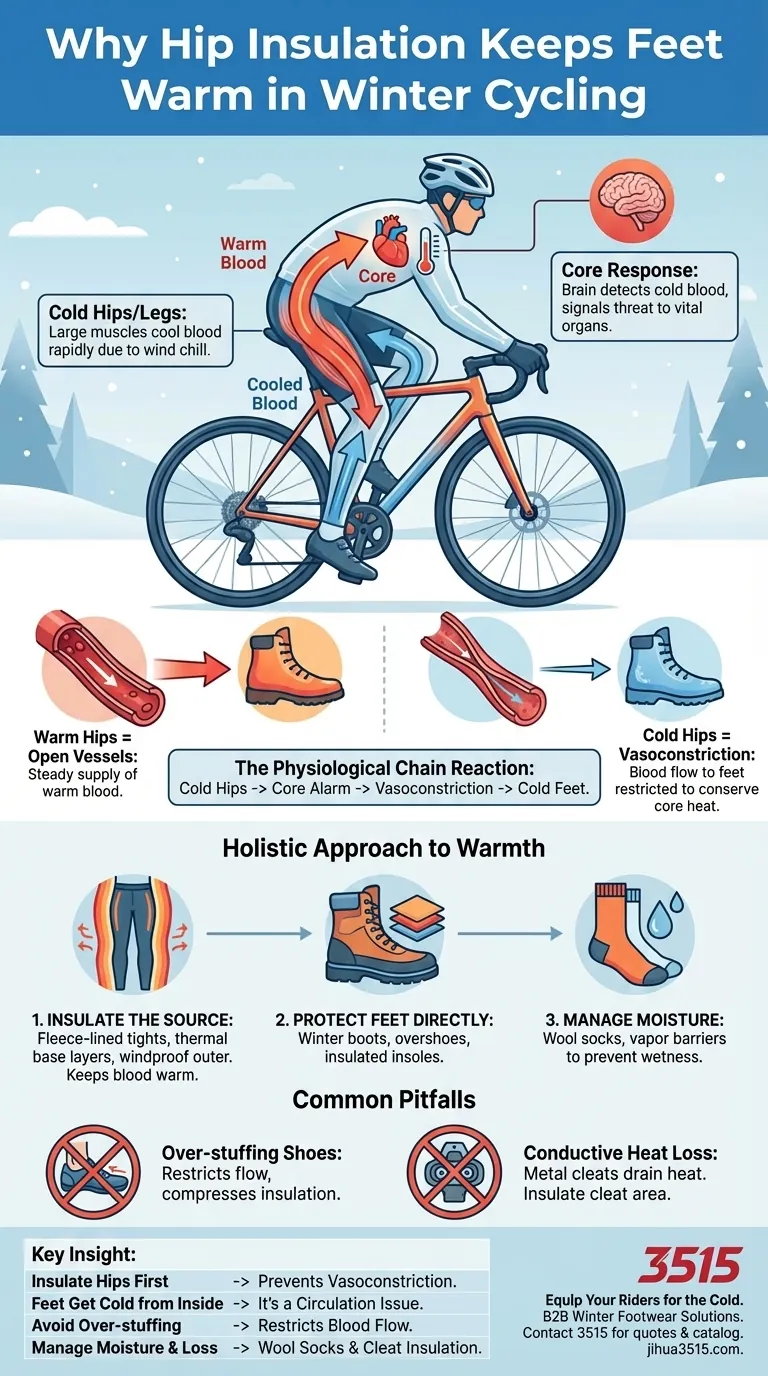The short answer is physiology. Insulating your hips and legs is crucial for warm feet because it prevents cold blood from returning to your body's core. When your core senses this cold blood, it triggers a self-preservation response, restricting blood flow to your extremities—like your feet—to keep your vital organs warm.
The most common mistake in fighting cold feet is focusing only on the feet. True warmth comes from managing your entire body as a system, where keeping your large leg and hip muscles warm is the first and most critical step to ensure warm blood continues to circulate to your toes.

The Physiological Chain Reaction: From Hips to Toes
To solve the problem of cold feet, you must first understand the body's internal logic. Your body is a smart thermostat, and its top priority is protecting your vital organs.
How Cold Hips Trigger a Core Response
Your thighs and glutes contain some of the largest muscles in your body. As you cycle, they are exposed to significant wind chill, causing the large volume of blood flowing through them to cool rapidly.
This cooled blood then circulates back to your torso. Your brain interprets this drop in blood temperature as a serious threat to your core, signaling that the entire system is losing heat too quickly.
Vasoconstriction: The Body's Survival Instinct
In response to this perceived threat, your body initiates vasoconstriction. This is the process of narrowing blood vessels in your peripheral areas, specifically your hands and feet.
By reducing blood flow to the extremities, your body conserves heat for the most critical organs in your core. It is a survival mechanism that effectively sacrifices the comfort of your toes to ensure the function of your heart, lungs, and brain.
The Impact on Your Feet
Once vasoconstriction begins, it doesn't matter how insulated your boots are. Feet without a steady supply of warm blood are like a house with the furnace turned off—they will inevitably get cold from the inside out. This is why cyclists can have the best winter boots and still suffer from numb, painful toes.
A Holistic Approach to Warmth
Effective warmth is about defending against heat loss at every point in the system, not just at the final destination.
Step 1: Insulate the Source
Your first line of defense is insulating your legs and hips. For temperatures down to -5°C (23°F), fleece-lined cycling tights or thermal long johns under a shell are effective. In deeper cold, add a windproof outer layer. This simple step keeps the blood circulating through your legs warm, preventing the initial trigger for vasoconstriction.
Step 2: Protect the Feet Directly
Once you've secured the blood supply, you can focus on direct foot protection.
- Winter Cycling Boots: The gold standard, offering built-in insulation and wind/waterproofing.
- Overshoes (Booties): A versatile solution that fits over your regular cycling shoes. Using two layers of booties can be effective in very cold conditions, provided they don't restrict circulation.
- Insulated Insoles: These create a thermal barrier to stop heat loss through the bottom of your shoe, especially where metal cleats and pedals conduct cold.
Step 3: Manage Moisture
Wet feet are cold feet, whether the moisture comes from snow and rain or your own sweat.
- Wool Socks: Merino wool is excellent at insulating even when damp and wicking moisture away from the skin.
- Vapor Barriers: Some riders use thin plastic bags or specialized waterproof socks (like SealSkinz) between a thin liner sock and a heavier wool sock. This can be effective but may also trap sweat, so it requires careful management.
Understanding the Common Pitfalls
Even with the right gear, common mistakes can undermine your efforts and lead to cold feet.
Over-stuffing Your Shoes
The most frequent error is wearing socks that are too thick for your shoes. This compresses your foot, restricts blood flow, and packs down the sock's insulation, making your feet colder, not warmer. If you need thicker socks, you may need a larger shoe.
Ignoring Conductive Heat Loss
Your shoe's cleat is a major point of conductive heat loss. The metal acts as a thermal bridge, pulling warmth directly out of your foot. Sealing the cleat holes inside your shoe with silicone or placing an insulating material like closed-cell foam in your insoles can help mitigate this.
Focusing Only on the Symptom
Ultimately, the biggest pitfall is treating cold feet as a foot problem. It is a full-body circulation problem. Without addressing the insulation of your hips and legs, any effort you put into your footwear will be a losing battle.
How to Apply This to Your Ride
Your strategy should adapt to the conditions and duration of your ride.
- If your primary focus is short commutes in mild cold: Start with a good pair of wool socks and neoprene overshoes. Ensure you are wearing thermal tights or long johns to keep your legs warm.
- If your primary focus is long rides in deep cold: Invest in a layered system. This includes a thermal base layer for your legs, windproof tights or pants, and dedicated winter cycling boots.
- If your primary focus is a budget-conscious solution: Combine multiple layers of overshoes, use insulated insoles, and seal your shoe's cleat holes. Never neglect wearing thermal leg warmers or tights as your foundational layer.
By treating warmth as a system that begins at your core and extends to your hips, you can finally win the battle against cold feet.
Summary Table:
| Key Insight | Why It Matters |
|---|---|
| Insulate Hips & Legs First | Prevents cold blood from triggering core protection mode (vasoconstriction). |
| Feet Get Cold from the Inside | Without warm blood flow, even the best boots fail. It's a circulation issue. |
| Avoid Over-Stuffing Shoes | Thick socks can restrict blood flow, making feet colder. |
| Manage Moisture & Conductive Loss | Wet feet and metal cleats drain heat. Use wool socks and insulate cleat areas. |
Ready to equip your riders for the cold?
As a large-scale manufacturer, 3515 produces a comprehensive range of high-performance winter cycling footwear for distributors, brand owners, and bulk clients. Our production capabilities encompass all types of insulated boots and overshoes designed to work in harmony with proper base layers, ensuring total body warmth.
Let's discuss how our durable, weatherproof footwear solutions can keep your customers' feet warm and comfortable on every ride.
Contact our team today for quotes and catalog!
Visual Guide

Related Products
- Customizable Slip-On Safety Shoes Direct from the Factory for Wholesale
- Wholesale Customizable Suede Safety Boots - Puncture-Proof with Velcro Closure
- Wholesale Durable 6-Inch Work Boots | Custom & Private Label Manufacturer
- Durable Leather Work Boots Wholesale Manufacturer & Custom Factory
- Wholesale Smart Casual Sneakers with Dial Closure | Factory Direct Manufacturing
People Also Ask
- What are the potential consequences of wearing improperly designed work boots? Avoid Injury & Boost Safety
- What are the cultural perspectives on wearing shoes in the house? A Guide to Home Etiquette & Hygiene
- What is the purpose of ASTM International? A Guide to Global Quality Standards
- How do safety shoes contribute to cost savings for companies? A Strategic Investment in Risk and Cost Management
- What regular maintenance checks should be performed on safety boots? A Daily Safety Checklist



















